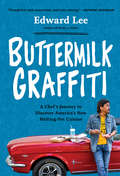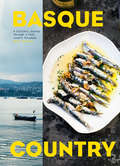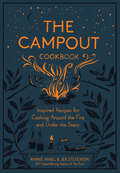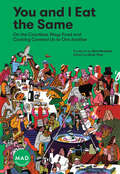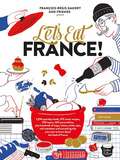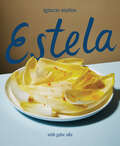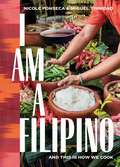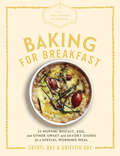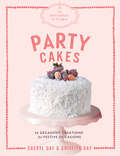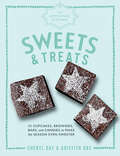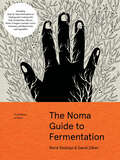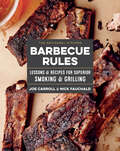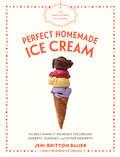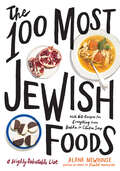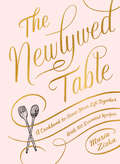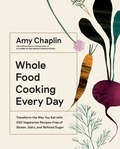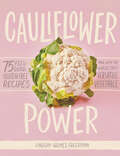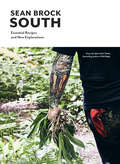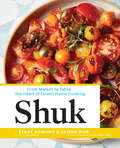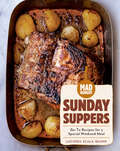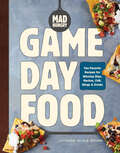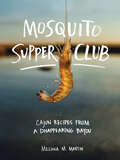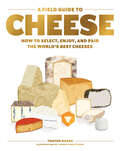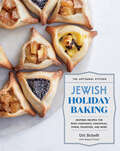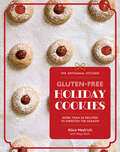- Table View
- List View
Buttermilk Graffiti: A Chef's Journey to Discover America's New Melting-Pot Cuisine
by Edward Lee“Thoughtful, well researched, and truly moving. Shines a light on what it means to cook and eat American food, in all its infinitely nuanced and ever-evolving glory.” —Anthony Bourdain Named one of Publishers Weekly’s Top 10 Food Books for Spring 2018 American food is the story of mash-ups. Immigrants arrive, cultures collide, and out of the push-pull come exciting new dishes and flavors. But for Edward Lee, who, like Anthony Bourdain or Gabrielle Hamilton, is as much a writer as he is a chef, that first surprising bite is just the beginning. What about the people behind the food? What about the traditions, the innovations, the memories? A natural-born storyteller, Lee decided to hit the road and spent two years uncovering fascinating narratives from every corner of the country. There’s a Cambodian couple in Lowell, Massachusetts, and their efforts to re-create the flavors of their lost country. A Uyghur café in New York’s Brighton Beach serves a noodle soup that seems so very familiar and yet so very exotic—one unexpected ingredient opens a window onto an entirely unique culture. A beignet from Café du Monde in New Orleans, as potent as Proust’s madeleine, inspires a narrative that tunnels through time, back to the first Creole cooks, then forward to a Korean rice-flour hoedduck and a beignet dusted with matcha. Sixteen adventures, sixteen vibrant new chapters in the great evolving story of American cuisine. And forty recipes, created by Lee, that bring these new dishes into our own kitchens.
Basque Country: A Culinary Journey Through a Food Lover's Paradise
by Marti Buckley“Truly insider access, an authentic look at the traditions of one of the most incredible culinary regions of the world.” —José AndrésFeatured as one of Food & Wine’s Best Cookbooks Coming Out This Fall Tucked away in the northwest corner of Spain, Basque Country not only boasts more Michelin-starred restaurants per capita than any other region in the world, but its unique confluence of mountain and sea, values and tradition, informs every bite of its soulful cuisine, from pintxos to accompany a glass of wine to the elbows-on-the-table meals served in its legendary eating clubs. Yet Basque Country is more than a little inaccessible—shielded by a unique language and a distinct culture, it’s an enigma to most outsiders. Until now. Marti Buckley, an American chef, journalist, and passionate Basque transplant, unlocks the mysteries of this culinary world by bringing together its intensely ingredient-driven recipes with stories of Basque customs and the Basque kitchen, and vivid photographs of both food and place. And surprise: this is food we both want to eat and can easily make. It’s not about exotic ingredients or flashy techniques. It’s about mind-set—how to start with that just-right fish or cut of meat or peak-of-ripeness tomato and coax forth its inherent depth of flavor. It’s the marriage of simplicity and refinement, and the joy of cooking for family and friends.
The Campout Cookbook: Inspired Recipes for Cooking Around the Fire and Under the Stars
by Jen Stevenson Marnie HanelForget freeze-dried astronaut meals and bags of stale, store-bought gorp. Finally, here’s a cookbook that complements the magic of gathering around a campfire and sharing a meal with friends. From the IACP Award–winning authors of The Picnic, which brought taste and style to eating outdoors (in the daytime), comes its companion, for leaving civilization behind and dining under the stars. A mix of dishes to make ahead and meals to cook on-site, The Campout Cookbook includes more than 75 recipes for wood-fired skillet pizzas; backcountry stews and chilies; fire-roasted vegetables and cast-iron breads; unexpected dips, jerkies, and high-energy bars; breakfasts to satisfy that yawning hunger that comes from sleeping in the fresh air; s’mores, of course (including Vanilla Bean Dream Marshmallows & Co. and Dark Chocolate Raspberry Caramel Fire-Ban S’mores); and cocktails, coolers, warm libations for chilly nights, and a Blood Orange Bug Juice. Plus there’s inspiration and know-how for every avid camper and enthusiastic neophyte: How to find a suitable campsite and build a campfire specifically for cooking over, and how to keep it going. Stargazing for city slickers. A troubleshooting guide. And the definitive packing list and camp kitchen essentials. Just add a few scary stories for a truly memorable campout.
You and I Eat the Same: On the Countless Ways Food and Cooking Connect Us to One Another (MAD Dispatches, Volume 1) (Dispatches #1)
by Chris Ying René Redzepi MadMAD Dispatches: Furthering Our Ideas About Food Good food is the common ground shared by all of us, and immigration is fundamental to good food. In eighteen thoughtful and engaging essays and stories, You and I Eat the Same explores the ways in which cooking and eating connect us across cultural and political borders, making the case that we should think about cuisine as a collective human effort in which we all benefit from the movement of people, ingredients, and ideas. An awful lot of attention is paid to the differences and distinctions between us, especially when it comes to food. But the truth is that food is that rare thing that connects all people, slipping past real and imaginary barriers to unify humanity through deliciousness. Don’t believe it? Read on to discover more about the subtle (and not so subtle) bonds created by the ways we eat. Everybody Wraps Meat in Flatbread: From tacos to dosas to pancakes, bundling meat in an edible wrapper is a global practice. Much Depends on How You Hold Your Fork: A visit with cultural historian Margaret Visser reveals that there are more similarities between cannibalism and haute cuisine than you might think. Fried Chicken Is Common Ground: We all share the pleasure of eating crunchy fried birds. Shouldn’t we share the implications as well? If It Does Well Here, It Belongs Here: Chef René Redzepi champions the culinary value of leaving your comfort zone. There Is No Such Thing as a Nonethnic Restaurant: Exploring the American fascination with “ethnic” restaurants (and whether a nonethnic cuisine even exists). Coffee Saves Lives: Arthur Karuletwa recounts the remarkable path he took from Rwanda to Seattle and back again.
Let's Eat France!
by François-Régis GaudryThere’s never been a book about food like Let’s Eat France! A book that feels literally larger than life, it is a feast for food lovers and Francophiles, combining the completist virtues of an encyclopedia and the obsessive visual pleasures of infographics with an enthusiast’s unbridled joy. <p><p> Here are classic recipes, including how to make a pot-au-feu, eight essential composed salads, pâté en croûte, blanquette de veau, choucroute, and the best ratatouille. Profiles of French food icons like Colette and Curnonsky, Brillat-Savarin and Bocuse, the Troigros dynasty and Victor Hugo. A region-by-region index of each area’s famed cheeses, charcuterie, and recipes. Poster-size guides to the breads of France, the wines of France, the oysters of France—even the frites of France. You’ll meet endive, the belle of the north; discover the croissant timeline; understand the art of tartare; find a chart of wine bottle sizes, from the tiny split to the Nebuchadnezzar (the equivalent of 20 standard bottles); and follow the family tree of French sauces. <p> Adding to the overall delight of the book is the random arrangement of its content (a tutorial on mayonnaise is next to a list of places where Balzac ate), making each page a found treasure. It’s a book you’ll open anywhere—and never want to close.
Estela
by Ignacio Mattos Gabe UllaOne flight up, in a bustling neighborhood bistro overlooking the chaos of one of downtown New York’s busiest streets, Ignacio Mattos serves food so uncannily delicious it consistently earns him accolades like “Chef of the Year,” and his restaurant Estela a spot among the World’s 50 Best. Everyone wants a taste of Estela, from loyal local customers to out-of-town foodies, visiting chefs to visiting presidents. The food is bold, bright, layered, playful, and surprising. Innovative without being precious. Comfort food, really. Food that bursts to life in your mouth—food that hits you right there. Estela, the long-awaited cookbook, shows how to think like Ignacio Mattos, who as an immigrant sees ingredients with fresh eyes. Here is how to look at something as ordinary as a button mushroom and make it extraordinary (shaved thin over ricotta dumplings), or as familiar as burrata and transform it (with a pool of juiced herby greens and charred bread). How to use vinegars, citruses, fish sauce, and pickling broth to give each bite a pop of flavor. How to compose a plate in layers, so that the deeper you dig, the more that is revealed, while each forkful carries an electric marriage of flavors and textures. Estela presents over 133 recipes, including classics that will never leave the menu, like Lamb Ribs with Chermoula and Honey, Mussels Escabeche on Toast, and the hide-and- seek joy of Endive Salad with Walnuts and Ubriaco Rosso. Small plates meant for sharing with friends and family, like Cherry Tomatoes with Figs and Onion. Incredible pan-seared steaks. And basics for the pantry that will elevate whatever you feel like making. Estela is the restaurant, but Estela is far more than a restaurant cookbook. It’s an inviting and creative expression of Mattos’s fresh and influential style.
I Am a Filipino: And This Is How We Cook
by Nicole Ponseca Miguel TrinidadNamed a New York Times Best Cookbook of Fall 2018 Filipino food is having its moment. Sour, sweet, funky, fatty, bright, rich, tangy, bold—no wonder adventurous eaters consider Filipino food the next big thing (Vogue declares it “the next great American cuisine”). Filipinos are the second-largest Asian population in America, and finally, after enjoying Chinese, Japanese, Thai, and Vietnamese food, we’re ready to embrace Filipino food, too. Written by trailblazing restaurateurs Nicole Ponseca and Miguel Trinidad, I Am a Filipino is a cookbook of modern Filipino recipes that captures the unexpected and addictive flavors of this vibrant and diverse cuisine. The techniques (including braising, boiling, and grilling) are simple, the ingredients are readily available, and the results are extraordinary. There are puckeringly sour adobos with meat so tender you can cut it with a spoon, along with other national dishes like kare-kare (oxtail stew) and kinilaw (fresh seafood dressed in coconut milk and ginger). There are Chinese-influenced pansit (noodle dishes) and lumpia (spring rolls); Arab-inflected cuisine, with its layered spicy curries; and dishes that reflect the tastes and ingredients of the Spaniards, Mexicans, and Americans who came to the Philippines and stayed. Included are beloved fried street snacks like ukoy (fritters), and an array of sweets and treats called meryenda. Filled with suitably bold and bright photographs, I Am a Filipino is like a classic kamayan dinner—one long, festive table piled high with food. Just dig in!
The Artisanal Kitchen: 33 Muffin, Biscuit, Egg, and Other Sweet and Savory Dishes for a Special Morning Meal (The Artisanal Kitchen)
by Griffith Day Cheryl DayMake the happiest meal of the day even happier with 33 recipes for baked deliciousness from Cheryl and Griffith Day, New York Times bestselling authors and owners of Savannah’s must-visit Back in the Day Bakery. Whether you’re hosting a brunch or feeding the family, try these irresistible recipes for authentic Old-Fashioned Buttermilk Biscuits; inspired muffins, coffee cakes, and quick breads; one beautiful Farmers’-Market Quiche; and so much more. This book has been adapted from The Back in the Day Bakery Cookbook (Artisan, 2012) and Back in the Day Bakery Made with Love (Artisan, 2015).
The Artisanal Kitchen: 36 Decadent Creations for Festive Occasions (The Artisanal Kitchen)
by Griffith Day Cheryl DayNothing makes a statement like a celebration cake, especially when you bake it from scratch. Cheryl and Griffith Day, New York Times bestselling authors and owners of Savannah’s must-visit Back in the Day Bakery, touch all the high points of American cake magic—coconut, red velvet, carrot with cream cheese frosting, chocolate (both traditional and flourless), spice, angel food, and the essential pineapple upside-down— with 36 truly decadent, showstopping creations. This book has been adapted from The Back in the Day Bakery Cookbook (Artisan, 2012) and Back in the Day Bakery Made with Love (Artisan, 2015).
The Artisanal Kitchen: 33 Cupcakes, Brownies, Bars, and Candies to Make the Season Even Sweeter (The Artisanal Kitchen)
by Griffith Day Cheryl DayCheryl and Griffith Day, New York Times bestselling authors and owners of Savannah’s must-visit Back in the Day Bakery, share 33 homespun recipes for delicious special occasion entertaining. Try Pumpkin Crunch Bars for a Thanksgiving table, Gingerbread Cupcakes with Lemon–Cream Cheese Frosting for a caroling party, Pecan Brittle as a hostess gift, and Salted Caramel Popcorn when it’s time to pile into the den together and watch a favorite holiday movie. This book has been adapted from The Back in the Day Bakery Cookbook (Artisan, 2012) and Back in the Day Bakery Made with Love (Artisan, 2015).
The Noma Guide to Fermentation: Including koji, kombuchas, shoyus, misos, vinegars, garums, lacto-ferments, and black fruits and vegetables (Foundations of Flavor)
by René Redzepi David ZilberA New York Times Best Cookbook of Fall 2018At Noma—four times named the world’s best restaurant—every dish includes some form of fermentation, whether it’s a bright hit of vinegar, a deeply savory miso, an electrifying drop of garum, or the sweet intensity of black garlic. Fermentation is one of the foundations behind Noma’s extraordinary flavor profiles. Now René Redzepi, chef and co-owner of Noma, and David Zilber, the chef who runs the restaurant’s acclaimed fermentation lab, share never-before-revealed techniques to creating Noma’s extensive pantry of ferments. And they do so with a book conceived specifically to share their knowledge and techniques with home cooks. With more than 500 step-by-step photographs and illustrations, and with every recipe approachably written and meticulously tested, The Noma Guide to Fermentation takes readers far beyond the typical kimchi and sauerkraut to include koji, kombuchas, shoyus, misos, lacto-ferments, vinegars, garums, and black fruits and vegetables. And—perhaps even more important—it shows how to use these game-changing pantry ingredients in more than 100 original recipes. Fermentation is already building as the most significant new direction in food (and health). With The Noma Guide to Fermentation, it’s about to be taken to a whole new level.
The Artisanal Kitchen: Lessons and Recipes for Superior Smoking and Grilling (The\artisanal Kitchen Ser.)
by Nick Fauchald Joe CarrollGreat barbecue and grilled meats are at the heart of summer cooking, and in this book from barbecue expert Joe Carroll, fire-cooked foods are approachable and downright delicious. With more than 30 mouthwatering recipes and six informational essays in this handy book—adapted from Carroll’s Feeding the Fire—he proves that you don’t need fancy equipment or long-held regional traditions to make succulent barbecue and grilled meats at home. Barbecue Rules teaches the hows and whys of live-fire cooking: how to roast a pork loin (and what cut to ask your butcher for), how to create low and slow heat, why quality meat matters, and how to make the best sides to accompany the main event (the key is to keep it simple). With recipes for classics like Beef Brisket and Pulled Pork Shoulder and more adventurous flavors like Sweet Tea–Brined Poussins and Lamb Saddle Chops with Mint-Yogurt Sauce, there are recipes for every palate and outdoor occasion.
The Artisanal Kitchen: The Best Make-It-Yourself Ice Creams, Sorbets, Sundaes, and Other Desserts (The\artisanal Kitchen Ser.)
by Jeni Britton BauerNothing beats delicious artisanal ice cream, and this bite-sized book is full of highly doable recipes that can be made in a $50 home-cook-friendly ice cream machine. <P><P>The craveable ice creams and frozen yogurts favorites include strawberry, pistachio, and vanilla but also creative combinations like Farmstead Cheese and Guava Jam Ice Cream and Wild Berry Lavender Ice Cream. Mix and match them into sundaes decked with crunchy “gravels” (delicious crumbly toppings), syrups, and more to create an unforgettable sweets experience. <P><P>From Graham Cracker Ice Cream to Baked Rhubarb Frozen Yogurt to the One Night in Bangkok Sundae, these recipes—adapted from Jeni Britton Bauer’s Jeni’s Splendid Ice Creams at Home and Jeni’s Splendid Ice Cream Desserts—make up a must-have collection of decadent desserts.
The 100 Most Jewish Foods: A Highly Debatable List
by Alana NewhouseWith contributions from Ruth Reichl, Éric Ripert, Joan Nathan, Michael Solomonov, Dan Barber, Yotam Ottolenghi, Tom Colicchio, Maira Kalman, Melissa Clark, and many more!Tablet’s list of the 100 most Jewish foods is not about the most popular Jewish foods, or the tastiest, or even the most enduring. It’s a list of the most significant foods culturally and historically to the Jewish people, explored deeply with essays, recipes, stories, and context. Some of the dishes are no longer cooked at home, and some are not even dishes in the traditional sense (store-bought cereal and Stella D’oro cookies, for example). The entire list is up for debate, which is what makes this book so much fun. Many of the foods are delicious (such as babka and shakshuka). Others make us wonder how they’ve survived as long as they have (such as unhatched chicken eggs and jellied calves’ feet). As expected, many Jewish (and now universal) favorites like matzo balls, pickles, cheesecake, blintzes, and chopped liver make the list. The recipes are global and represent all contingencies of the Jewish experience. Contributors include Ruth Reichl, Éric Ripert, Joan Nathan, Michael Solomonov, Dan Barber, Gail Simmons, Yotam Ottolenghi, Tom Colicchio, Amanda Hesser and Merrill Stubbs, Maira Kalman, Action Bronson, Daphne Merkin, Shalom Auslander, Dr. Ruth Westheimer, and Phil Rosenthal, among many others. Presented in a gifty package, The 100 Most Jewish Foods is the perfect book to dip into, quote from, cook from, and launch a spirited debate.
The Newlywed Table: A Cookbook to Start Your Life Together
by Maria ZizkaIf cooking for someone is an act of love, then what better way for a newlywed couple to express their love than to cook with each other? Author Maria Zizka offers 100 recipes for classic and modern recipes to build a young couple’s cooking repertoire. Couples will not only learn to cook as a team while creating meals to nourish themselves and friends and family but will master key culinary lessons in the process. Recipes such as Leek and Goat Cheese Tart and Spring Vegetable Curry with Rice Noodles are easy weeknight dinners, Seafood Stew with Saffron Broth and Whole Side of Salmon with Herb Sauce are made for entertaining, and One-Bowl Brownies and Birthday Cake will become beloved desserts. Zizka teaches readers how to store food properly and repurpose leftovers and explains topics newlywed couples will surely want to master: how to set up a pantry, set a table, plan a dinner party, create a signature cocktail, and cook together for a lifetime.
Whole Food Cooking Every Day: Transform the Way You Eat with 250 Vegetarian Recipes Free of Gluten, Dairy, and Refined Sugar
by Amy Chaplin“There’s no shortage of vegetarian cookbooks out there, but it’s rare that I find one that inspires me page after page as much as Amy Chaplin’s Whole Food Cooking Every Day.” —Bon Appétit Eating whole foods can transform a diet, and mastering the art of cooking these foods can be easy with the proper techniques and strategies. In 20 chapters, Chaplin shares ingenious recipes incorporating the foods that are key to a healthy diet: seeds and nuts, fruits and vegetables, whole grains, and other plant-based foods. Chaplin offers her secrets for eating healthy every day: mastering some key recipes and reliable techniques and then varying the ingredients based on the occasion, the season, and what you’re craving. Once the reader learns one of Chaplin’s base recipes, whether for gluten-free muffins, millet porridge, or baked marinated tempeh, the ways to adapt and customize it are endless: change the fruit depending on the season, include nuts or seeds for extra protein, or even change the dressing or flavoring to keep a diet varied. Chaplin encourages readers to seek out local and organic ingredients, stock their pantries with nutrient-rich whole food ingredients, prep ahead of time, and, most important, cook at home.
Cauliflower Power: 75 Feel-Good, Gluten-Free Recipes Made with the World's Most Versatile Vegetable
by Lindsay Grimes FreedmanLow in carbs, fats, and sugars, and naturally packed with vitamin C, cauliflower is the super-est of all superfoods. Why cauliflower? It’s a chameleon and can take on any flavor and texture. In her first cookbook, food blogger and recipe developer Lindsay Grimes Freedman brings her expertise in creating delicious, healthful, and practical recipes to one of the food world’s most trending topics: cauliflower. With more than 75 recipes built around the five ways to prep cauliflower (as a whole head, florets, steaks, riced, and meal), Freedman transforms this versatile veggie into smoothies and scones, pizza crusts and pasta sauces, and sides and salads. Super swaps include falafel made with cauliflower and Caesar salad made with a cauliflower-based dressing, even cauliflower nachos, “bacon” bits, tots, and French toast. The recipes are healthful and easily adaptable for any diet without skimping on flavor or satisfaction. By harnessing the power of this anti-inflammatory veggie, readers will reap all the benefits of a plant-based diet without missing out on any of the good stuff.
South: Essential Recipes and New Explorations
by Sean BrockNamed a Best New Cookbook of Fall 2019 by the New York Times, Food & Wine, Epicurious, Grub Street, and more “I will keep this book forever in my collection because no one cooking today is doing more to help the Southern culinary flame burn brighter.”—New York Times“Masterful. . . . Mouthwatering, virtuosic.”—Publishers Weekly, starred review Southern food is one of the most beloved and delicious cuisines in America. And who better to give us the key elements of Southern cuisine than Sean Brock, the award-winning chef and Southern-food crusader. In South, Brock shares his recipes for key components of the cuisine, from grits and fried chicken to collard greens and corn bread. Recipes can be mixed and matched to make a meal or eaten on their own. Taken together, they make up the essential elements of Southern cuisine, from fried green tomatoes to smoked baby back ribs and from tomato okra stew to biscuits. Regional differences are highlighted in recipes for shrimp and grits, corn bread, fried chicken, and more. Includes key Southern knowledge too: how to fry, how to care for cast iron, how to cook over a hearth, and more. This is the book fans of Sean Brock have been waiting for, and it’s the book Southern-food lovers the world over will use as their bible.
Shuk: From Market to Table, the Heart of Israeli Home Cooking
by Janna Gur Einat Admony“SHUK shouts ‘Cook me!” from every vibrant page.” —Boston Globe “Fascinating. . . . This energetic and exciting volume serves as an edifying deep dive into Israeli food market culture and cuisine.” —Publishers Weekly, starred review With Shuk, home cooks everywhere can now inhale the fragrances and taste the flavors of the vivacious culinary mash-up that is today’s Israel. The book takes you deeper into this trending cuisine, through the combined expertise of the authors, chef Einat Admony of Balaboosta and food writer Janna Gur. Admony’s long-simmered stews, herb-dominant rice pilafs, toasted-nut-studded grain salads, and of course loads of vegetable dishes—from snappy, fresh, and raw to roasted every way you can think of—will open your eyes and your palate to the complex nuances of Jewish food and culture. The book also includes authoritative primers on the well-loved pillars of the cuisine, including chopped salad, hummus, tabboulehs, rich and inventive shakshukas, and even hand-rolled couscous with festive partners such as tangy quick pickles, rich pepper compotes, and deeply flavored condiments. Through gorgeous photo essays of nine celebrated shuks, you’ll feel the vibrancy and centrality of the local markets, which are so much more than simply shopping venues—they’re the beating heart of the country. With more than 140 recipes, Shuk presents Jewish dishes with roots in Persia, Yemen, Libya, the Balkans, the Levant, and all the regions that contribute to the evolving food scene in Israel. The ingredients are familiar, but the combinations and techniques are surprising. With Shuk in your kitchen, you’ll soon be cooking with the warmth and passion of an Israeli, creating the treasures of this multicultural table in your own home.
Mad Hungry: Go-To Recipes for a Special Weekend Meal (The Artisanal Kitchen)
by Lucinda Scala QuinnThere’s no better way to prepare for the coming week than with a comforting meal, and here is trusted cookbook author Lucinda Scala Quinn with a collection of her best recipes for getting the family together on a Sunday night. Recipes for classic chicken dinners like Chicken Parmesan and Vinegar-Glossed Chicken, hearty beef stews, roasts, and appetizing sides like Maple-Thyme Roasted Carrots and Steamed Yet Crispy String Beans will make a satisfying dinner easier than ever. Everybody loves an excuse to gather around the table for a home-cooked meal, and these recipes will give you an excuse to do so more often.
Mad Hungry: Fan-Favorite Recipes for Winning Dips, Nachos, Chili, Wings, and Drinks (The Artisanal Kitchen)
by Lucinda Scala QuinnEverybody loves game day, and some of us love game-day food even more. Here is the complete playbook for all the snacks, sides, and mains you’ll need to feed the hungry crowd in your home or even at the tailgate. Impress with homemade Spinach Feta Pocket Pies and Quick Fried Chicken, or go for the tried-and-true classics like the perfect guacamole, queso fundido, or a French dip. Drinks like spiked lemonade and a spicy bloody Mary keep the party going.
Mosquito Supper Club: Cajun Recipes from a Disappearing Bayou
by Melissa M. MartinNamed a Best New Cookbook of Spring 2020 by Bon Appétit, Food & Wine, NPR&’s The Splendid Table, Eater, Epicurious, and more &“Martin shares the history, traditions, and customs surrounding Cajun cuisine and offers a tantalizing slew of classic dishes.&” —Publishers Weekly, starred review For anyone who loves Cajun food or is interested in American cooking or wants to discover a distinct and engaging new female voice—or just wants to make the very best duck gumbo, shrimp jambalaya, she-crab soup, crawfish étouffée, smothered chicken, fried okra, oyster bisque, and sweet potato pie—comes Mosquito Supper Club. Named after her restaurant in New Orleans, chef Melissa M. Martin&’s debut cookbook shares her inspired and reverent interpretations of the traditional Cajun recipes she grew up eating on the Louisiana bayou, with a generous helping of stories about her community and its cooking. Every hour, Louisiana loses a football field&’s worth of land to the Gulf of Mexico. Too soon, Martin&’s hometown of Chauvin will be gone, along with the way of life it sustained. Before it disappears, Martin wants to document and share the recipes, ingredients, and customs of the Cajun people. Illustrated throughout with dazzling color photographs of food and place, the book is divided into chapters by ingredient—from shrimp and oysters to poultry, rice, and sugarcane. Each begins with an essay explaining the ingredient and its context, including traditions like putting up blackberries each February, shrimping every August, and the many ways to make an authentic Cajun gumbo. Martin is a gifted cook who brings a female perspective to a world we&’ve only heard about from men. The stories she tells come straight from her own life, and yet in this age of climate change and erasure of local cultures, they feel universal, moving, and urgent.
A Field Guide to Cheese: How to Select, Enjoy, and Pair the World's Best Cheeses
by Tristan SicardA Field Guide to Cheese is the ultimate guide to the world of cheese and the only fully illustrated cheese reference. This tour de fromage begins with a history lesson on the creation of cheese, offers a primer of the many types of milks and categories of cheeses, and then leads readers to an encyclopedic survey of over 400 global cheeses. There are cheeses we all love like feta and fontina, Gouda and mozzarella, Pecorino Romano and chèvre—but also rarities like King River Gold, a washed-rind cheese from Australia; Dancing Fern, a raw cow’s-milk cheese from Tennessee; and Danbo, a semisoft, aged cheese from Denmark. Find cheeses that are best for melting, like hushållsost; those that are best served alone, such as bovški sir; and those that are the stinkiest, like Allgäuer Weisslacker. There are cheeses with natural rinds, floral rinds, and soft rinds; curd cheeses; spreadable cheeses; pressed cheeses; whey cheeses; fresh cheeses; and more! A global collection of maps place each cheese to its origin, and readers can take their knowledge even further by reading up on the microbial life of cheese and the science behind our tasting palates. Packed with information, this book is for professional cheesemongers just as much as it is for those with a simple love of cheese.
The Artisanal Kitchen: Inspired Recipes for Rosh Hashanah, Hanukkah, Purim, Passover, and More (The Artisanal Kitchen)
by Uri ScheftIn Jewish Holiday Baking, adapted from his Breaking Breads, Uri Scheft shares key classic holiday baking recipes like challah and babka—and provides his creative twists on them as well, showing how bakers can do the same easily at home. But the book is not limited to breads alone. Holiday sweets, whether chocolate‑filled babka, poppyseed hamantaschen, or fruit-filled sufganiyot, are recipes of dessert-lovers&’ dreams. And with the addition of traditional Middle Eastern breads like kubaneh and jachnun, this collection of holiday recipes from master baker Scheft becomes an indispensable resource. The instructions are detailed and the photos explanatory so that anyone can make Scheft&’s Chocolate and Orange Confit Challah, Za&’atar Twists, and Jerusalem Bagels for their next Seder or Apple Hamantaschen for Purim.
The Artisanal Kitchen: More Than 30 Recipes to Sweeten the Season (The Artisanal Kitchen)
by Alice MedrichHolidays are the time for baking and enjoying cookies and treats, and those with gluten sensitivities shouldn&’t have to miss out. Baking with flavor flours—oat flour, sorghum flour, teff, coconut flour, and nut flours, like almond and hazelnut—means that everyone can enjoy holiday treats, from the classic Chocolate Chip Cookie to the decadent Peanut Crunch Brownies. Alternative flours make these cookies and bars gluten-free. And rather than simply adding starch and structure to a dessert (as is the case with wheat flour), these flours elevate the taste of every cookie and bar too. With seasonal favorites like Quince and Orange-Filled Chestnut Cookies, Chocolate Sablés, and Brown Sugar Pecan Cookies, these recipes—adapted from Alice Medrich&’s Flavor Flours—make a must-have mini compendium of decadent gluten-free holiday desserts.
